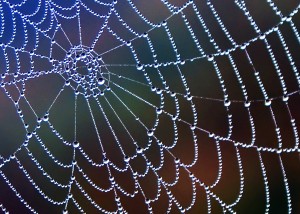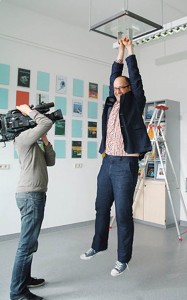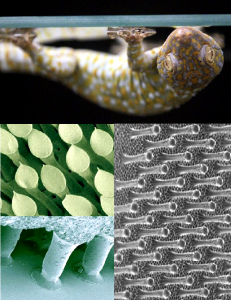
When it comes to superhero abilities—seeing in the dark, walking on ceilings, or being bulletproof—nature is miles ahead of any current technology. Recognizing that it’s easier to replicate a design than to build one from the ground up, scientists are looking to the natural world for innovative designs or materials that are strong, lightweight, or that have unique abilities.
Biomimicry is not exactly a new science. Past inventions include Velcro in 1941 (its hundreds of tiny hooks are based on plant burrs that lodge in fur and clothing) and cat’s eyes reflectors in 1933 (based on their namesake). The trend continues today.

Here at Oregon State University, Professor Kaichang Li of the wood science and engineering department is studying how blue mussels on the Oregon coast create remarkably adhesive, waterproof glue. Anyone who’s ever tried to prise a mussel off a slick rock can appreciate the seemingly supernatural strength of its binding agent. The mussels produce strong, flexible tethers made of amino acids. There’s no smell, no hazardous chemicals; perhaps most impressively, it’s waterproof. The latter is an exceptionally useful ability, say, when trying to repair a windshield during the Northwest’s rainy season. Li’s research could lead to a widely used, safe and effective glue made from a cheaper source of protein: soy.
Other projects include an effort to make a flexible, bulletproof vest out of spiders’ silk. Some spiders can produce silk that is stronger than Kevlar, yet much lighter. In the future, scientists envision building lightweight, flexible body armor either by synthesizing spider silk or by growing silkworms, bacteria, or other easy-to-cultivate organisms that could produce similar silk.
Meanwhile, German researchers have created a “gecko tape” inspired by the unique abilities of a gecko’s feet. A piece of the reusable tape that is less than 8 inches on a side can hold the weight of an average person.

And while superhero abilities are still out of reach for most of us, biomimicry is in some instances giving perceptive abilities back to the disabled. Based on the echolocation used by bats and dolphins, the UltraCane lets blind individuals “see” obstacles in front of them. Ultrasonic waves return to the user in the form of vibrations in the handle of the cane, specific to which side of the street it is on and even its height. Developed in the U.K., the product is now available in the U.S.
As our ability to replicate new materials improves, expect to see more technologies that mimic the natural world. Researchers at Princeton are working on solar cells designed like leaves, while other companies are producing fabrics for swimmers based on shark skin (something Speedo has already attempted with dubious success). After all, before working to build something in a lab from the ground up, it only makes sense to see what evolution has managed to craft after millions of years of refinement. It might be good to note that most creatures that are winning the game of natural selection don’t seem to use hazardous chemicals as common binding agents… But, hey, a mussel couldn’t possibly be smarter than a human, right?
by Jen Matteis
Do you have a story for The Advocate? Email editor@corvallisadvocate.com

